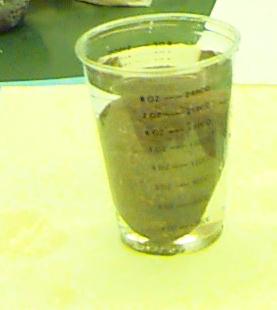

The cup holds 240 ml, so the volume of the rock is 110 ml.
In a solar-heated house, you would want to store energy gathered during the day to keep the house warm at night. You could do this by making a tank of warm water, or by warming up some rocks. Which system would store more energy (assuming the volume and temperature was the same)? This activity will help answer this question.
Materials:
The activity has two parts: in the first part we establish a rule that tells us what happens when we let objects of different temperatures interact. In the second part, we use the rule to compare a volume of water to a volume of rock in its ability to store thermal energy.
The very first thing we need, however, is to determine the
volume of the rock we will study.
The most accurate is to find a container that is big enough to
hold the whole rock but otherwise as small as possible.
Put
the rock in, and then measure how much water it takes to fill
the container right to a measuring line (or the brim).
Then measure how much water it takes to fill the empty
container to the same mark. The rock volume is the difference between these.
 
|
| With the rock in it, it took 130 ml of water to fill the
cup. The cup holds 240 ml, so the volume of the rock is 110 ml. |
|---|
After you have measured the volume of the rock, put it in the container containing ice and water, so that it will be nice and cold when you get to part B of the activity.
Part A
Procedure:
Part B
Procedure:
Check the box when you are done:
Another activity involving sharing of thermal energy